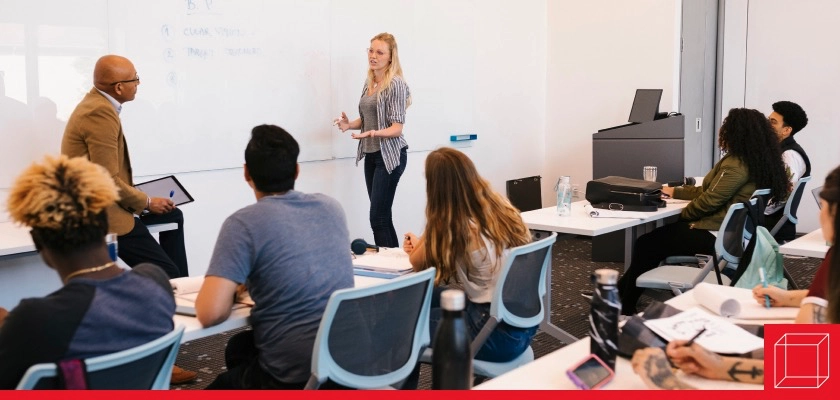It’s Time to Rethink How We Teach Today’s College Students
Pairing adaptive learning with career planning is key for instructors to meeting the needs of the students today.

Bob Dylan’s 1964 song “The Times They Are A-Changing” is very relevant for higher education. Did you know that the four-year graduation rate for students attending public college and universities is 33.3%? The rate goes up to 57.6% for six years. The graduation rates are 52.8% and 65.4% for four-year and six-year graduations respectively at private colleges and universities.1 Parents and administrators are not happy with this result, and I believe that the pressure to improve student success will trickle down to faculty.
Employers Are a Force for Change Within Higher Education
In addition to low graduation rates, employers actually represent a key force for change in higher education. After all, a successful career is the end goal for most college students and employers themselves are looking for qualified candidates to join their ranks. More specifically, they are looking to hire students who possess the skills needed to produce the products and services desired by consumers. The problem is that employers see a gap in students’ career readiness, and they partially blame academic institutions for this skills gap.
Career Readiness
Career readiness reflects the extent to which students possess the knowledge, skills, and attributes desired by employers. A study by Hart Research Associates, which consisted of 400 employers and 613 students, asked respondents to rate the extent to which college graduates were skilled at using 17 different competencies. The following results were uncovered:
- Students rated themselves as career-ready on 11 of 17 competencies.
- Employers did not perceive students as career-ready on any of the 17 competencies.
- The top five competency gaps in estimated career readiness included:
- critical/analytical thinking,
- written communication,
- working with people from different backgrounds,
- applying knowledge/skills to real-world problems,
- and analyzing/solving complex problems.2
Career Readiness Competencies
There have been many studies that have investigated the competencies associated with career readiness,3 and my coauthor and I summarized the findings in our textbook titled Management: A Practical Introduction. We identified 27 competencies and concluded that seven of them were “core” (i.e. they are relevant to just about any job).
The core competencies include:
- Critical thinking/problem solving
- Oral/written communication
- Teamwork/collaboration
- Information technology application
- Leadership
- Professionalism/work ethic
- Cross-cultural competency4
Students of Today are Also a Force for Change Within Higher Education
I have taught Baby Boomers (born 1946-1964), Gen Xers (born 1965-1979), Millennials/Gen Y (born 1980-1994), and Gen Z (born 1995-2012) students over the years. While some people may dismiss generational differences, there is some compelling research to support learning differences across age groups. My own teaching experience underscores that understanding students’ characteristics, needs, desires, and motivations are essential to successful teaching. Today, Gen Zs constitute 32% of the global population and they are the dominant generation in higher education. Their characteristics suggest that it is not most effective to teach them with past, proven ways.
Characteristics of Gen Zs
Gen Zs are affected by the fact that they were born into the war on terror, school shootings, and the great recession. They are the first generation that are “true” digital natives and they like to seek and use information from the internet. Common characteristics include the following:5
- Competitive
- Desire immediacy
- Embrace diversity and inclusion
- Pragmatic and career-oriented
- Short attention span and like to multitask
- Independent
- Care about online and personal safety
- Prefer hands-on learning that is experienced-based
- Prefer interactivity and collaboration while learning
Implications for Teaching Gen Z Students
Based on the above characteristics, it’s important for all educators to consider a few key questions:
- What type of teaching techniques are most likely to enhance Gen Z learning? Lectures? Case studies? Role plays? Experiential activities?
- Do Gen Zs care about being career ready? The answer is yes based on their practical and career-driven orientations.
- How can I adjust my teaching style and approach to be more effective for my Gen Z students?
Recommendations
Attending teaching symposia across the U.S. is one of the benefits of being an author for McGraw-Hill. I have talked with hundreds of faculty about teaching styles and techniques during these sessions. One important observation is that faculty spend too much time lecturing. Although there are many reasons for this trend, lecturing is not the best learning modality for Gen Z students. Gen Z’s prefer active learning techniques that involve collaboration and the practical application of what is being learned. Lecturing also is not the best way to develop a student's career readiness because these competencies require higher levels of learning that require an application, analysis, and evaluation. So, what can we do?
Replace “Content-Focused” Learning with a “Learner-Centered” Approach
Moving away from focusing solely on content in the classroom and instead focusing on the application is not an easy switch. However, this type of change in learning structure will help better meet the needs and desires of Gen Z students. Simply put, lectures are not the best way to teach Gen Z students. That’s not to say you stop lecturing altogether, just reduce it to no more than 25% of class time. Given Gen Zs strong practical and career orientation, I also encourage you to find ways to develop career readiness competencies within the content of your courses.
Focus on Active Learning That Is Hands-On, Experiential, and Engaging
Active learning involves a problem-based approach. One expert noted that “active learners take new information and apply it, rather than merely taking note of it.”6 This results in more student engagement and higher levels of academic performance.7Active learning techniques involve using one or more of the following:
- discussion
- debate
- small group work
- self-assessments
- role-plays
- video demonstrations
- case studies
- and guest speakers8
Consider New Forms of Assessment
Multiple-choice exams can be used to assess lower levels of knowledge, but more advanced assessment techniques are needed to evaluate higher levels of learning and proficiency in developing career readiness. For example, I like to grade “contribution” during each class. My method also involves getting input from two student graders.
Incorporate Technology into the Learning Process
Gen Zs are accustomed to learning from a digital device, websites, visual media, simulations, and social media. Find ways to incorporate technology into pre-class preparation, during class activities, and after class reinforcement and assessment.
Find Ways for Students to Learn from Independent Exploration and Group-Based Collaboration
Gen Z’s desire for independence reinforces the value of giving students tasks to pursue on their own. Then, use group-based activities both in and out of class to satisfy Gen Zs desire to work with others.
The times in higher education are indeed changing. Employer desires and student expectations necessitate that we reconsider the methods being used to teach today’s students. It’s time to step away from the podium and engage in active learning.
1 See Lynn O’Shaughnessy, College Insider, Cappex, https://www.cappex.com/articles/blog/government-publishes-graduation-rate-data, accessed July 23, 2019.
2 Results can be found in “Falling Short? College Learning and Career Success,” Hart Research Associates, 2015.
3 See NACE Staff, “The Four Career Competencies Employers Value Most,” National Association of College and Employers, March 29, 2019, https://www.naceweb.org/career-readiness/competencies/the-four-career-competencies-employers-value-most; and Fátima Suleman, “The Employability Skills of Higher Education Graduates: Insights Into Conceptual Frameworks and Methodological Options,” Higher Education, 2018, pp.263-278. 4 See Angelo Kinicki and Brian Williams, Management: A Practical Introduction (9th ed.; New York: McGraw-Hill, 2020).
5 See Josh Miller, “10 Things You Need to Know About Gen Z,” HR Magazine, 2018, pp. 51-56; and Jennifer Chicca and Teresa Shellenbarger, “Connecting with Generation Z: Approaches in Nursing Education,” Teaching and Learning in Nursing, 2018, pp. 180-184.
6 Craig Lambert, “Twilight of the Lecture,” Harvard Magazine, 2012, https://harvardmagazine.com/2012/03/twilight-of-the-lecture, p. 3.
7 See Scott Freeman et al., “Active Learning Increases Student Performance in Science, Engineering, and Mathematics,” PNAS Early Edition, 2014, pp. 1-6; and Robin Kay, Thom MacDonald, and Maurice DiGiuseppe, “A Comparison of Lecture-Based, Active, and Flipped Classroom Teaching Approaches in Higher Education,” Journal of Computing in Higher Education, 2018, https://doi.org/10.1007/s12528-018-9197-x.
8 For a review, see Norman Eng, Teaching College: The Ultimate Guide to Lecturing, Presenting, and Engaging Students (New York: Norman Eng, 2017).
